Tourist Agroforestry Landscape from the Perception of Local Communities: A Case Study of Rwenzori, Uganda
Abstract
:1. Introduction
2. Materials and Methods
2.1. Study Area
2.2. Data Collection
3. Results
3.1. Landscape Perception
3.2. Tourism Perception
3.3. Local People’s Knowledge of Two Invasive Non-Native Plant Species
4. Discussion
4.1. Landscape Perception
4.2. Tourism Perception
4.3. Local People’ Knowledge of Two Invasive Non-Native Plant Species
5. Conclusions
Supplementary Materials
Author Contributions
Funding
Institutional Review Board Statement
Informed Consent Statement
Data Availability Statement
Acknowledgments
Conflicts of Interest
Appendix A. Land Cover Change Analysis
Appendix A.1. Material and Methods
Appendix A.2. Results and Discussion
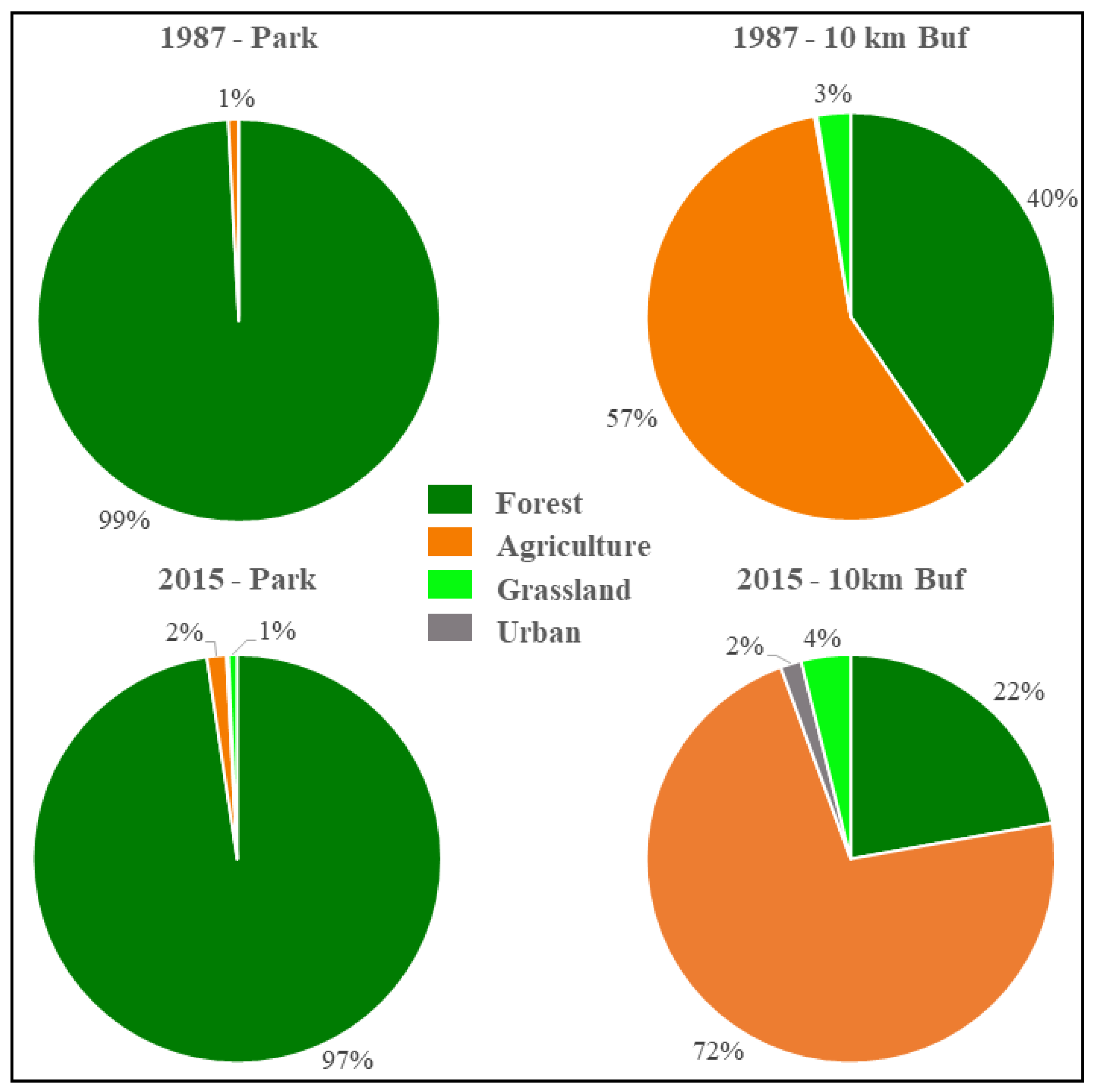
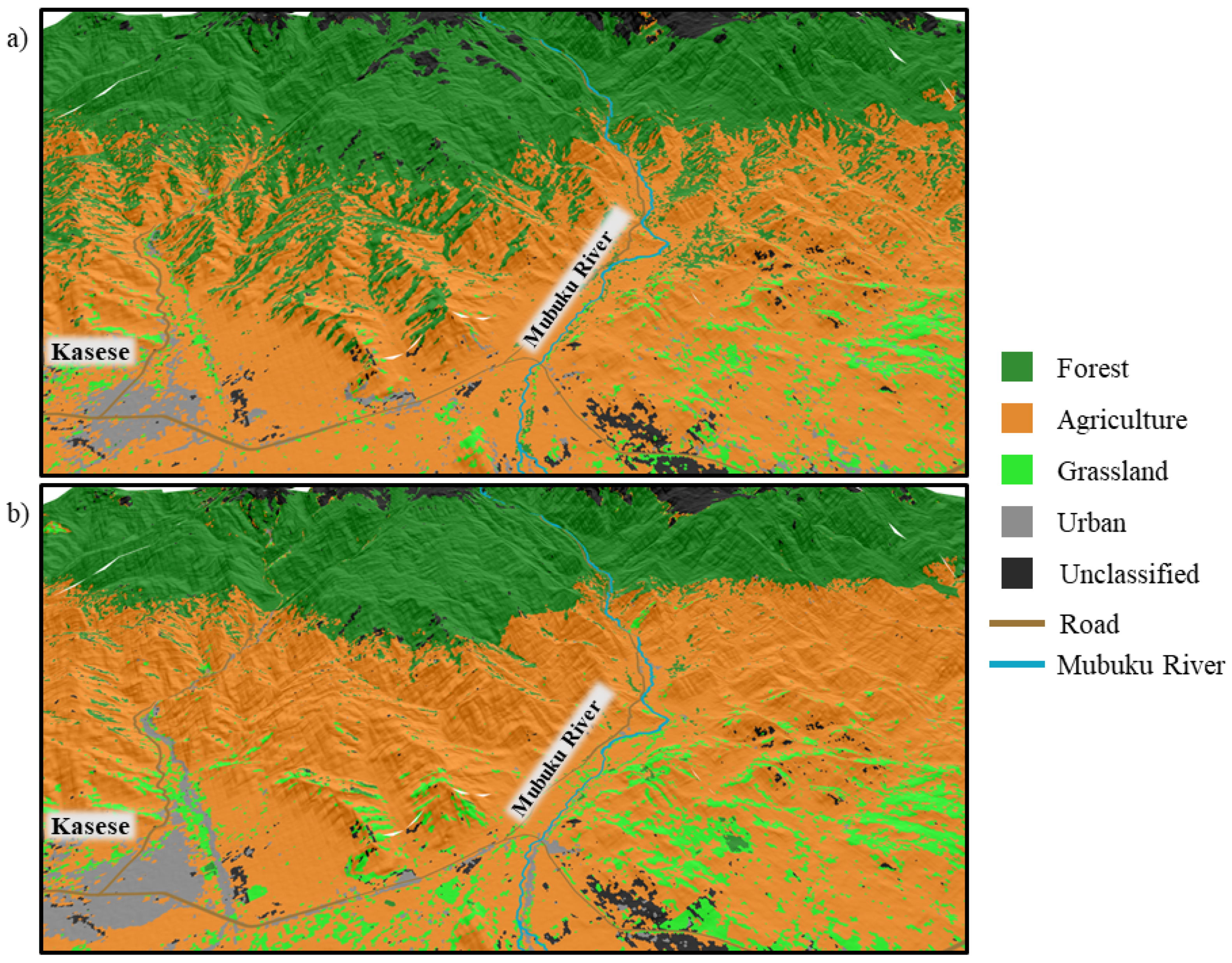
References
- Mill, R.C.; Morrison, A.M. The Tourism System, 1st ed.; Prentice-Hall: Englewood Cliffs, NJ, USA, 1985. [Google Scholar]
- Gkoltsiou, A.; Terkenli, T.S. An interdisciplinary analysis of tourist landscape structure. Tour. Int. Multidiscip. J. Tour. 2012, 7, 145–164. [Google Scholar]
- Pearce, D.G. Tourism Today: A Geographical Analysis, 2nd ed.; Longman Scientific & Technical: Canterbury, UK, 1995. [Google Scholar]
- Jafari, J. The components and nature of tourism: The tourism market basket of goods and services. Ann. Tour. Res. 1974, 1, 73–89. [Google Scholar] [CrossRef]
- Briassoulis, H. Sustainable tourism and the question of the commons. Ann. Tour. Res. 2002, 29, 1065–1085. [Google Scholar] [CrossRef]
- Tumusiime, D.M. Dependence on Environmental Income by Households around Rwenzori Mountain National Park, Western Uganda; Norwegian University of Life Science: Noragric, Norway, 2006. [Google Scholar]
- Tumusiime, D.M.; Vedeld, P.; Gombya-Ssembajjwe, W. Breaking the law? Illegal livelihoods from a Protected Area in Uganda. For. Policy Econ. 2011, 13, 273–283. [Google Scholar] [CrossRef]
- Wunder, S.; Angelsen, A.; Belcher, B. Forests, livelihoods, and conservation: Broadening the empirical base. World Dev. 2014, 64, S1–S11. [Google Scholar] [CrossRef] [Green Version]
- DeFries, R.; Hansen, A.; Turner, B.L.; Reid, R.; Liu, J. Land use change around protected areas: Management to balance human needs and ecological function. Ecol. Appl. 2007, 17, 1031–1038. [Google Scholar] [CrossRef] [PubMed]
- Gadd, M.E. Conservation outside of parks: Attitudes of local people in Laikipia, Kenya. Environ. Conserv. 2005, 32, 50–63. [Google Scholar] [CrossRef] [Green Version]
- Garrard, R.; Kohler, T.; Price, M.F.; Byers, A.C.; Sherpa, A.R.; Maharjan, G.R. Land use and land cover change in Sagarmatha National Park, a world heritage site in the Himalayas of Eastern Nepal. Mt. Res. Dev. 2016, 36, 299–310. [Google Scholar] [CrossRef]
- Howard, P.C.; Davenport, T.R.B.; Kigenyi, F.W.; Viskanic, P.; Baltzer, M.C.; Dickinson, C.J.; Lwanga, J.; Matthews, R.A.; Mupada, E. Protected area planning in the tropics: Uganda’s national system of forest nature reserves. Conversat. Biol. 2000, 14, 858–875. [Google Scholar] [CrossRef] [Green Version]
- Matson, P.A.; Parton, W.J.; Power, A.G.; Swift, M.J. Agricultural intensification and ecosystem properties. Science 1997, 277, 504–509. [Google Scholar] [CrossRef] [Green Version]
- Mwavu, E.N.; Witkowski, E.T.F. Land-Use and Cover Changes (1988–2002) around Budongo Forest Reserve, NW Uganda: Implications for Forest and Woodland Sustainability. Land Degrad. Dev. 2008, 19, 606–622. [Google Scholar] [CrossRef]
- Turner, I.M.; Corlett, R.T. The conservation value of small, isolated fragments of lowland tropical rain forest. Trends Ecol. Evol. 1996, 11, 330–333. [Google Scholar] [PubMed]
- Putz, F.E.; Blate, G.M.; Redford, K.H.; Fimbel, R.; Robinson, J. Tropical forest management and conservation of biodiversity: An overview. Conserv. Biol. 2001, 15, 7–20. [Google Scholar] [CrossRef] [Green Version]
- Hansen, A.J.; DeFries, R. Ecological mechanisms linking protected areas to surrounding lands. Ecol. Appl. 2007, 17, 974–988. [Google Scholar] [CrossRef] [PubMed]
- Bollmann, K.; Braunisch, V. To integrate or to segregate: Balancing commodity production and biodiversity conservation in European forests. In Integrative Approaches as an Opportunity for the Conservation of Forest Biodiversity; Kraus, D., Krumm, F., Eds.; European Forest Institute: Freiburg, Germany, 2013. [Google Scholar]
- Castella, J.-C.; Lestrelin, G.; Hett, C.; Bourgoin, J.; Fitriana, Y.R.; Heinimann, A.; Pfund, J.-L. Effects of landscape segregation on livelihood vulnerability: Moving from extensive shifting cultivation to rotational agriculture and natural forests in northern Laos. Hum. Ecol. 2013, 41, 63–76. [Google Scholar] [CrossRef]
- Bulafu, C.E.; Tumusiime, D.M.; Erik Hårklau, S.; Owuor, G. Status of illegal resource extraction within Rwenzori Mountains National Park, Uganda: Baseline studies near four hydropower projects. Afr. J. Ecol. 2021, 59, 449–465. [Google Scholar] [CrossRef]
- Buhanga, E.; Namuli, S.; Kapere, R.; Kayanja, K.F.; Mbogha, F.; Edson, T.; Gangiriba, R.; Enyagu, N.; Guma, N.; Kooli, A.; et al. Rwenzori Mountains National Park General Management Plan 2016–2025; Uganda Wildlife Authority: Kampala, Uganda, 2016. [Google Scholar]
- Didham, R.K.; Tylianakis, J.M.; Hutchison, M.A.; Ewers, R.M.; Gemmell, N.J. Are invasive species the drivers of ecological change? Trends Ecol. Evol. 2005, 20, 470–474. [Google Scholar] [CrossRef]
- García-Llorente, M.; Martín-López, B.; González, J.A.; Alcorlo, P.; Montes, C. Social perceptions of the impacts and benefits of invasive alien species: Implications for management. Biol. Conserv. 2008, 141, 2969–2983. [Google Scholar] [CrossRef] [Green Version]
- Vitousek, P.M.; D’Antonio, C.M.; Loope, L.L.; Rejmánek, M.; Westbrooks, R. Introduced species: A significant component of human-caused global change. N. Z. J. Ecol. 1997, 21, 1–16. [Google Scholar]
- Kendle, A.D.; Rose, J.E. The aliens have landed! What are the justifications for ‘native only’ policies in landscape plantings? Landsc. Urban Plan. 2000, 47, 19–31. [Google Scholar] [CrossRef]
- Scalera, R.; Genovesi, P.; Essl, F.; Rabitsch, W. The Impacts of Invasive Alien Species in Europe. Technical Report No 16/2012; European Environment Agency: Luxembourg, 2012; p. 114. [Google Scholar]
- Cordeiro, B.; Marchante, H.; Castro, P.; Marchante, E. Does public awareness about invasive plants pays off? An analysis of knowledge and perceptions of environmentally aware citizens in Portugal. Biol. Invasions 2020, 22, 2267–2281. [Google Scholar] [CrossRef]
- Cohen, E. The impact of tourism on the physical environment. Ann. Tour. Res. 1978, 5, 215–237. [Google Scholar] [CrossRef]
- Forman, R.T.T.; Alexander, L.E. Roads and their major ecological effects. Annu. Rev. Ecol. Syst. 1998, 29, 207–231. [Google Scholar] [CrossRef] [Green Version]
- Butler, R. Tourism Landscapes: For the Tourist or of the Tourist? Tour. Recreat. Res. 1992, 17, 3–9. [Google Scholar] [CrossRef]
- Barker, M.L. Traditional landscape and mass tourism in the Alps. Geogr. Rev. 1982, 72, 395–415. [Google Scholar] [CrossRef]
- Antrop, M. Landscape change: Plan or chaos? Landsc. Urban Plan. 1998, 41, 155–161. [Google Scholar] [CrossRef]
- Petrova, S.; Čihař, M.; Bouzarovski, S. Local nuances in the perception of nature protection and place attachment: A tale of two parks. Area 2009, 43, 327–335. [Google Scholar] [CrossRef]
- Galabuzi, C.; Tumwesigye, A. Current Knowledge, Attitudes and Practices of Local Communities Surrounding Rwenzori Mountains National Park; Faculty of Forestry and Nature Conservation, Makerere University: Kampala, Uganda, 2009. [Google Scholar]
- Bwambale, B.; Muhumuza, M.; Nyeko, M. Traditional ecological knowledge and flood risk management: A preliminary case study of the Rwenzori. JÀMbÁ J. Disaster Risk Stud. 2018, 10, a536. [Google Scholar] [CrossRef]
- Howard, P.C.; Butler, J.; Howard, P. Nature Conservation in Uganda’s Tropical Forest Reserves, 1st ed.; IUCN: Gland, Switzerland, 1991. [Google Scholar]
- Russell, J.; Eggermont, H.; Taylor, R.; Vershuren, D. Paleolimnological records of recent glacier recession in the Rwenzori Mountains, Uganda-D.R. Congo. J. Paleolimnol. 2009, 41, 253–271. [Google Scholar] [CrossRef]
- Osmaston, H. Guide to the Rwenzori: Mountains of the Moon, 2nd ed.; Titus Wilson: Kendal, UK, 2006; p. 288. [Google Scholar]
- Uganda Bureau of Statistics. The National Population and Housing Census 2014—Main Report; Uganda Bureau of Statistics: Kampala, Uganda, 2016; p. 108.
- Pennacini, C.; Wittenberg, H. Rwenzori: Histories and Cultures of an African Mountain; Fountain Publishers: Kampala, Uganda, 2007. [Google Scholar]
- EANST. Provision of Services for Conducting a Baseline Study and Mapping of Private Community Tourism Partnerships and Ecosystem Services Enterprises; East African Network for Sustainable Tourism: Kampala, Uganda, 2014; p. 139. [Google Scholar]
- Lepp, A. Residents’ attitudes towards tourism in Bigodi village, Uganda. Tour. Manag. 2007, 28, 876–885. [Google Scholar] [CrossRef]
- Kindt, R.; van Breugel, P.; Lillesø, J.P.B.; Minani, V.; Ruffo, C.K.; Gapusi, J.; Jamnadass, R.; Graudal, L. Potential Natural Vegetation of Eastern Africa: Volume 9. Atlas and Tree Species Composition for Rwanda; 8779036198; Department of Geosciences and Natural Resource Management, University of Copenhagen: Copenhagen, Denmark, 2014. [Google Scholar]
- Akosim, C.; Bode, A.S.; Kwaga, B.T.; Dishan, E.E. Perceptions and involvement of neighbouring communities of Kainji Lake National Park towards the Parks conservation programmes. J. Res. For. Wildl. Environ. 2010, 2, 44–59. [Google Scholar]
- Hamilton, A.C. A Field Guide to Uganda Forest Trees; Makerere University Printery: Kampala, Uganda, 1981. [Google Scholar]
- Andereck, K.L.; Vogt, C.A. The relationship between residents’ attitudes toward tourism and tourism development options. J. Travel Res. 2000, 39, 27–36. [Google Scholar] [CrossRef]
- Hartter, J.N. Attitudes of rural communities towards wetlands and forest fragments around Kibale National Park, Uganda. Hum. Dimens. Wildl. 2009, 14, 433–447. [Google Scholar]
- Zamani-Farahani, H.; Musa, G. Residents’ attitudes and perception towards tourism development: A case study of Masooleh, Iran. Tour. Manag. 2008, 29, 1233–1236. [Google Scholar] [CrossRef]
- Lepp, A. Tourism in a Rural Ugandan Village: Impacts, Local Meaning, and Implications for Development; University of Florida: Gainesville, FL, USA, 2004. [Google Scholar]
- Bwabu, E.; Rwenzori Mountaineering Services, Nyakalengija, Uganda. Personal communication, 2018.
- Sowińska-Świerkosz, B.; Chmielewski, T.J. Comparative assessment of public opinion on the landscape quality of two biosphere reserves in Europe. Environ. Manag. 2014, 54, 531–556. [Google Scholar]
- Selge, S.; Fischer, A.; van der Wal, R. Public and professional views on invasive non-native species–A qualitative social scientific investigation. Biol. Conserv. 2011, 144, 3089–3097. [Google Scholar] [CrossRef]
- Canavan, K.; Canavan, S.; Clark, V.R.; Gwate, O.; Richardson, D.M.; Sutton, G.F.; Martin, G.D. The alien plants that threaten South Africa’s mountain ecosystems. Land 2021, 10, 1393. [Google Scholar] [CrossRef]
- Ntalo, M.; Ravhuhali, K.E.; Moyo, B.; Hawu, O.; Msiza, N.H. Lantana camara: Poisonous Species and a Potential Browse Species for Goats in Southern Africa—A Review. Sustainability 2022, 14, 751. [Google Scholar]
- Shackleton, R.T.; Witt, A.B.; Aool, W.; Pratt, C.F. Distribution of the invasive alien weed, Lantana camara, and its ecological and livelihood impacts in eastern Africa. Afr. J. Range Forage Sci. 2017, 34, 1–11. [Google Scholar] [CrossRef]
- Syed, Z.; Guerin, P. Tsetse flies are attracted to the invasive plant Lantana camara. J. Insect Physiol. 2004, 50, 43–50. [Google Scholar] [CrossRef] [PubMed] [Green Version]
- Sala, O.E.; Chapin, F.S.; Armesto, J.J.; Berlow, E.; Bloomfield, J.; Dirzo, R.; Huber-Sanwald, E.; Huenneke, L.F.; Jackson, R.B.; Kinzig, A.; et al. Global biodiversity scenarios for the Year 2100. Science 2000, 287, 1770–1774. [Google Scholar] [CrossRef] [PubMed]
- Teye, V.; Sirakaya, E.; Sonmez, S.F. Residents’ attitudes toward tourism development. Ann. Tour. Res. 2002, 29, 668–688. [Google Scholar] [CrossRef]
- MacKenzie, C.A.; Salerno, J.; Hartter, J.; Chapman, C.A.; Reyna, R.; Tumusiime, D.M.; Drake, M. Changing perceptions of protected area benefits and problems around Kibale National Park, Uganda. J. Environ. Manag. 2017, 200, 217–228. [Google Scholar] [CrossRef] [PubMed]
- Byrne, G.F.; Crapper, P.F.; Mayo, K.K. Monitoring land-cover change by principal component analysis of multitemporal Landsat data. Remote Sens. Environ. 1980, 10, 175–184. [Google Scholar] [CrossRef]
- Dewan, A.M.; Yamaguchi, Y. Land use and land cover change in Greater Dhaka, Bangladesh: Using remote sensing to promote sustainable urbanization. Appl. Geogr. 2009, 29, 390–401. [Google Scholar] [CrossRef]
- Hansen, M.C.; Loveland, T.R. A review of large area monitoring of land cover change using Landsat data. Remote Sens. Environ. 2012, 122, 66–74. [Google Scholar] [CrossRef]
- Majaliwa, J.G.M.; Twongyirwe, R.; Nyenje, R.; Oluka, M.; Ongom, B.; Sirike, J.; Mfitumukiza, D.; Azanga, E.; Natumanya, R.; Mwerera, R.; et al. The effect of land cover change on soil properties around Kibale National Park in south western Uganda. Appl. Environ. Soil Sci. 2010, 2010, 7. [Google Scholar] [CrossRef] [Green Version]
- Owor, M.; Muwanga, A.; Pohl, W. Wetland change detection and inundation north of lake George, western Uganda using Landsat data. Afr. J. Sci. Technol. 2007, 8, 94–106. [Google Scholar]
- Yuan, F.; Sawaya, K.E.; Loeffelholz, B.C.; Bauer, M.E. Land cover classification and change analysis of the Twin Cities (Minnesota) Metropolitan Area by multitemporal Landsat remote sensing. Remote Sens. Environ. 2005, 98, 317–328. [Google Scholar] [CrossRef]
- USGS. Science for a Changing World. Available online: https://glovis.usgs.gov/ (accessed on 10 January 2018).
- Lepers, E.; Lambin, E.F.; Janetos, A.C.; DeFries, R.; Achard, F.; Ramankutty, N.; Scholes, R.J. A synthesis of information on rapid land-cover change for the period 1981–2000. BioScience 2005, 55, 115–124. [Google Scholar] [CrossRef]
- Southworth, J.; Hartter, J.; Binford, M.W.; Goldman, A.; Chapman, C.A.; Chapman, L.J.; Omeja, P.; Binford, E. Parks, people and pixels: Evaluating landscape effects of an East African national park on its surroundings. Trop. Conserv. Sci. 2010, 3, 122–142. [Google Scholar] [CrossRef]
- Figueroa, F.; Sánchez-Cordero, V. Effectiveness of natural protected areas to prevent land use and land cover change in Mexico. Biodivers. Conserv. 2008, 17, 3223–3240. [Google Scholar] [CrossRef]
- Hartter, J.N.; Ryan, S.J.; Southworth, J.; Chapman, C.A. Landscapes as continuous entities: Forest disturbance and recovery in the Albertine Rift landscape. Landsc. Ecol. 2011, 26, 877–890. [Google Scholar] [CrossRef]
- Loveland, T.R.; Sohl, T.; Sayler, K.; Gallant, A.; Dwyer, J.; Vogelmann, J.; Zylstra, G.; Wade, T.G.; Edmonds, C.M. Land Cover Trends: Rates, Causes, and Consequences of Late-Twentieth Century U.S. Land Cover Change; United States Environmental Protection Agency, Office of Research and Development: Washington, DC, USA, 1999.
- Twongyirwe, R. Forests under Threat? Changes in Land Use and Forest Cover in Rural Western Uganda; University of Cambridge: Cambridge, UK, 2015. [Google Scholar]
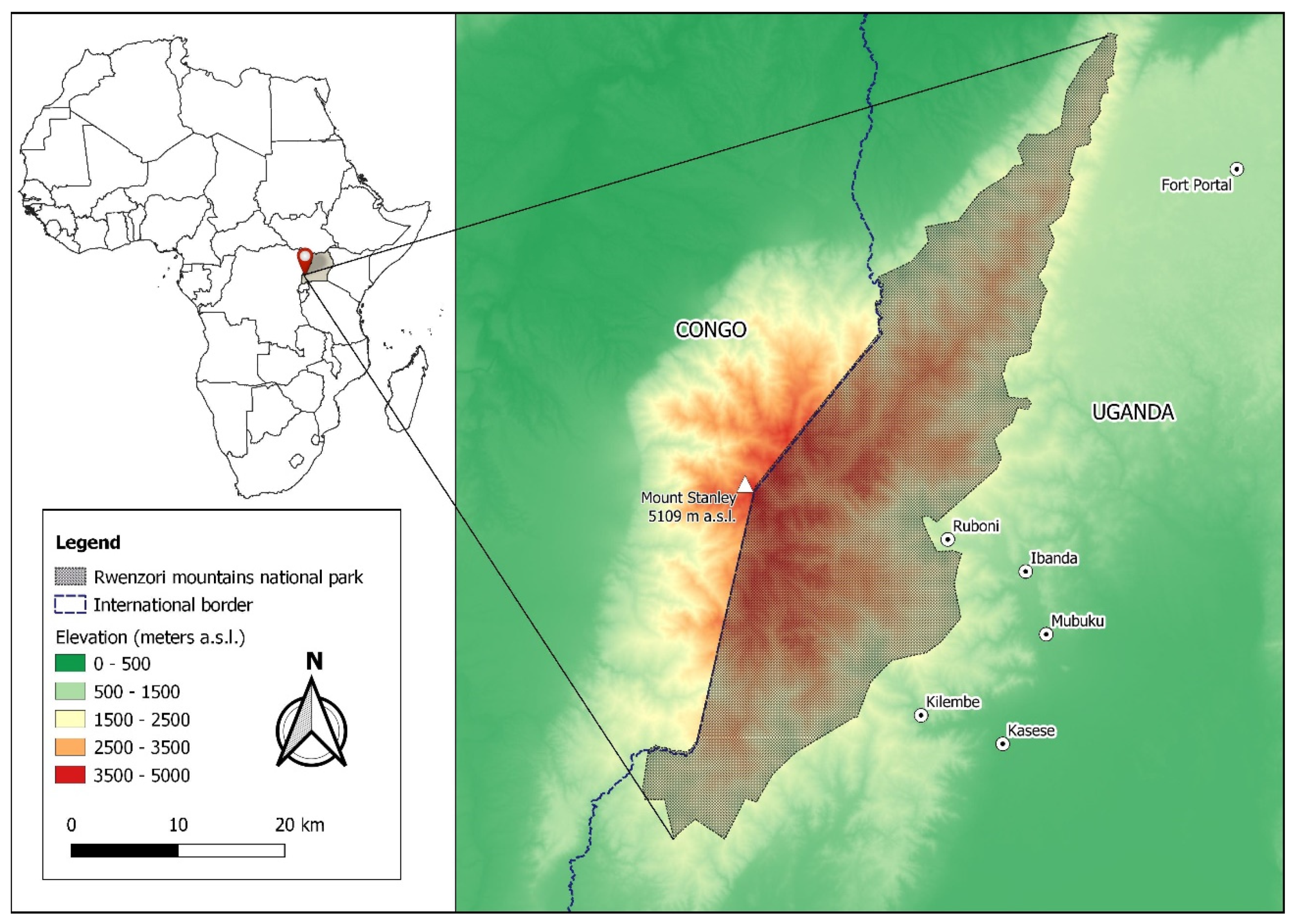
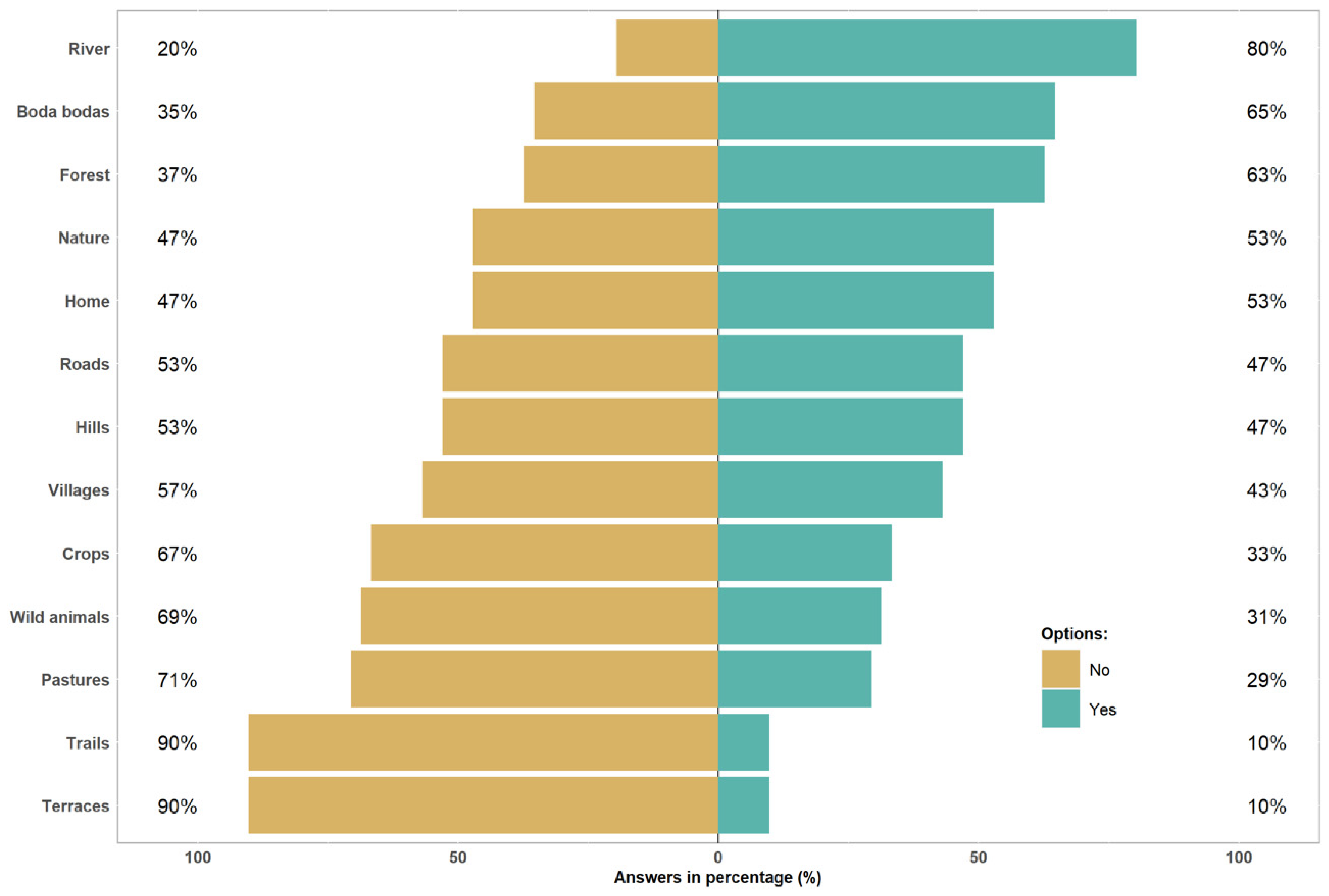
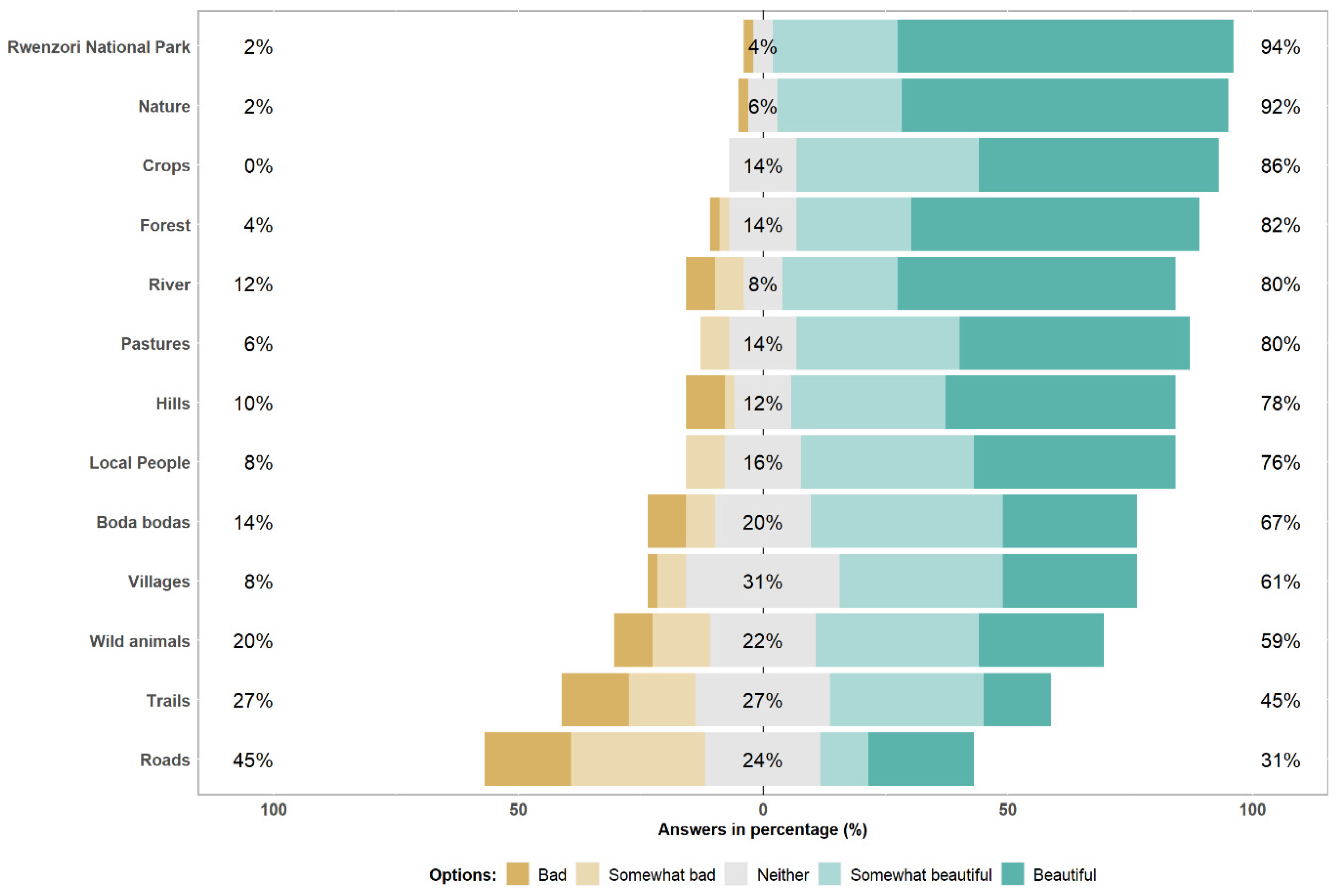
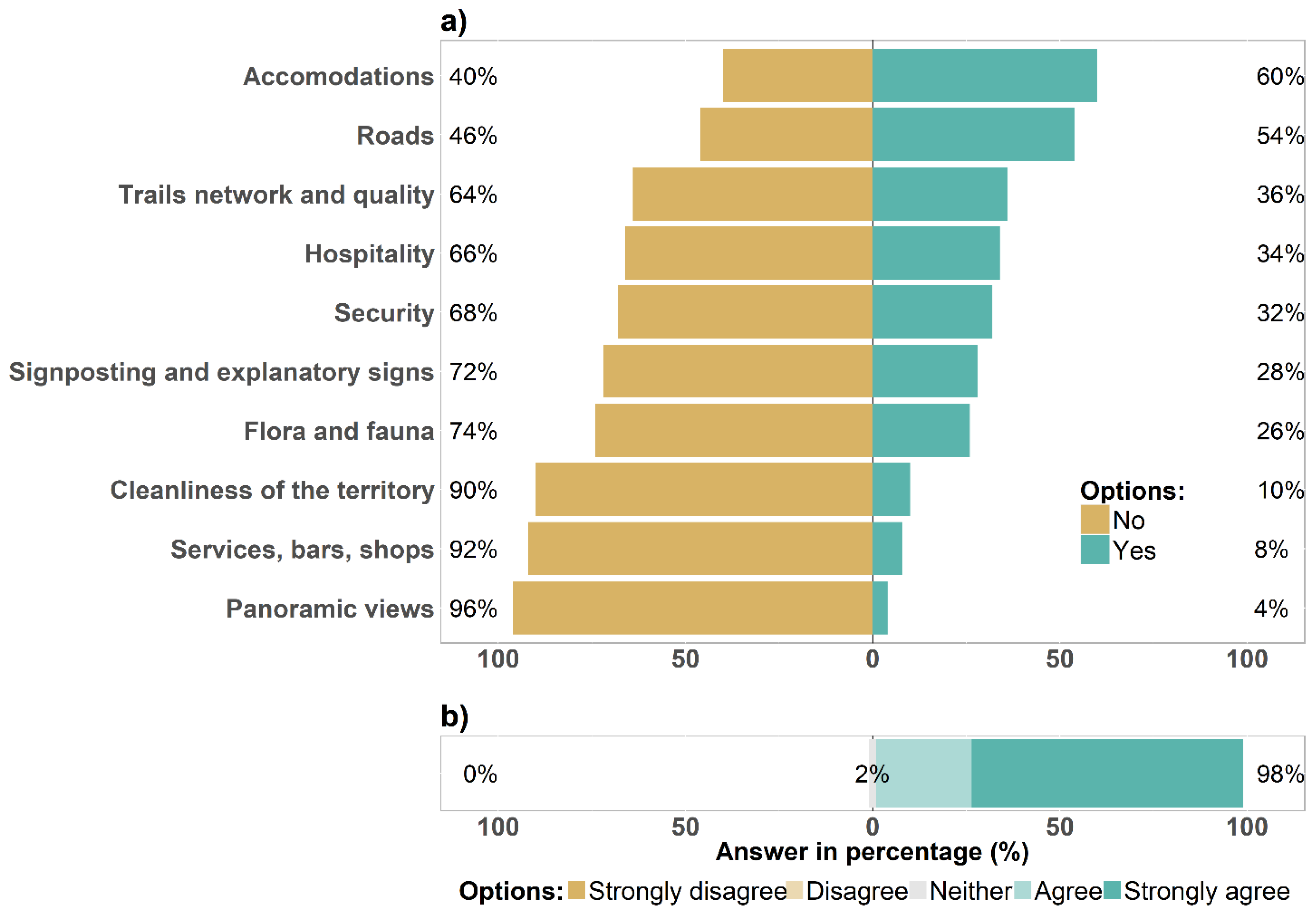
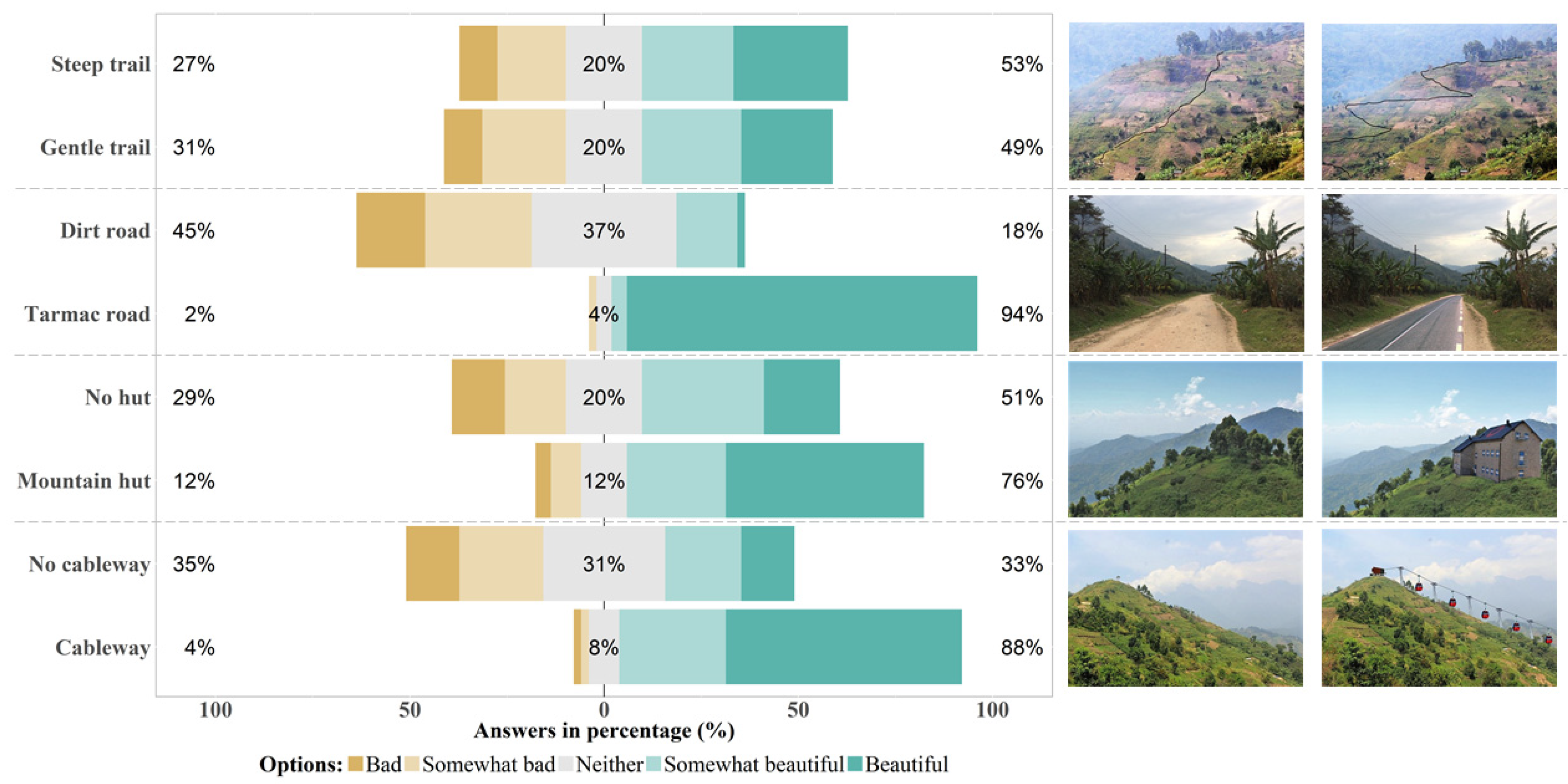
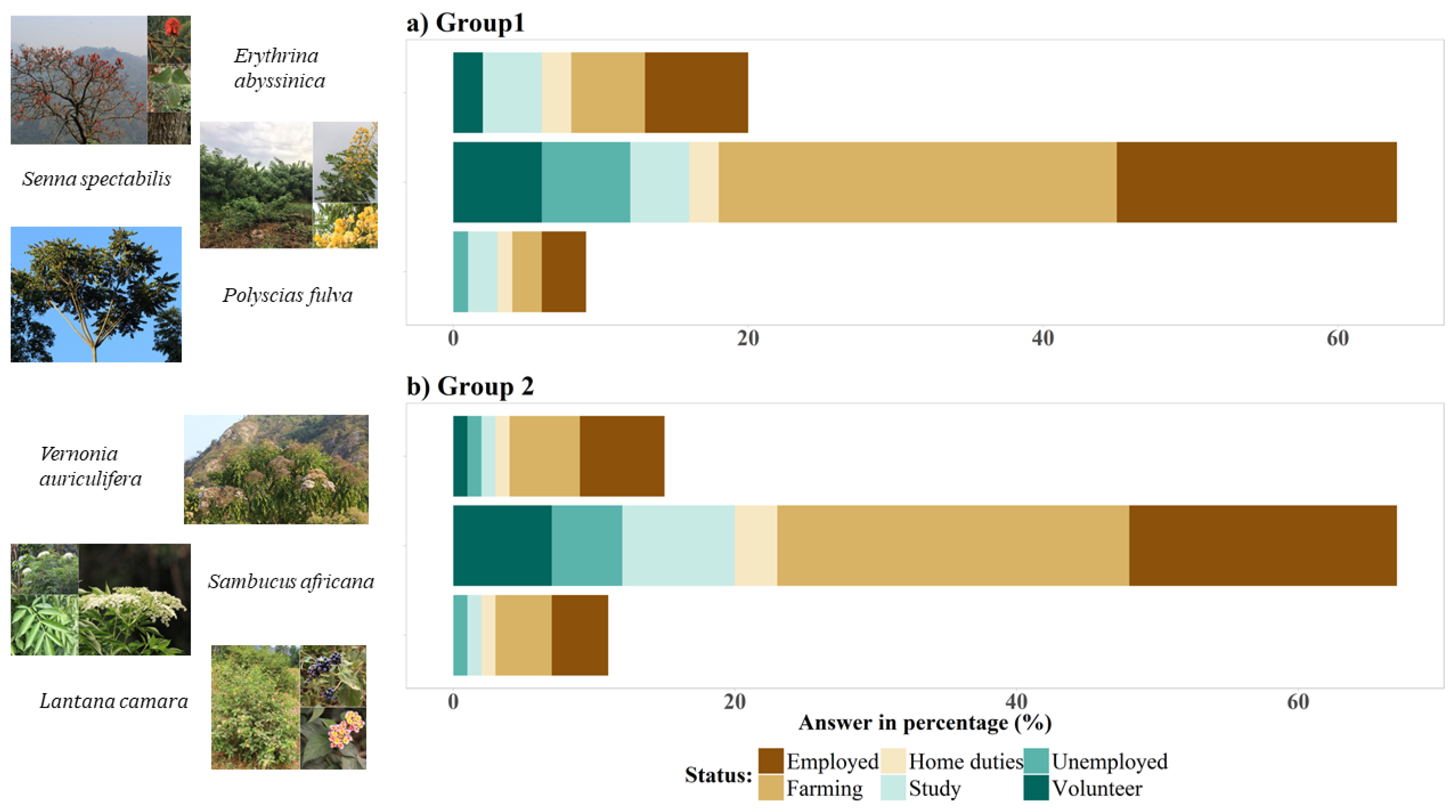
Publisher’s Note: MDPI stays neutral with regard to jurisdictional claims in published maps and institutional affiliations. |
© 2022 by the authors. Licensee MDPI, Basel, Switzerland. This article is an open access article distributed under the terms and conditions of the Creative Commons Attribution (CC BY) license (https://creativecommons.org/licenses/by/4.0/).
Share and Cite
Iacopino, S.; Piazzi, C.; Opio, J.; Muhwezi, D.K.; Ferrari, E.; Caporale, F.; Sitzia, T. Tourist Agroforestry Landscape from the Perception of Local Communities: A Case Study of Rwenzori, Uganda. Land 2022, 11, 650. https://doi.org/10.3390/land11050650
Iacopino S, Piazzi C, Opio J, Muhwezi DK, Ferrari E, Caporale F, Sitzia T. Tourist Agroforestry Landscape from the Perception of Local Communities: A Case Study of Rwenzori, Uganda. Land. 2022; 11(5):650. https://doi.org/10.3390/land11050650
Chicago/Turabian StyleIacopino, Simone, Carlo Piazzi, Julius Opio, Deus Kamunyu Muhwezi, Efrem Ferrari, Filippo Caporale, and Tommaso Sitzia. 2022. "Tourist Agroforestry Landscape from the Perception of Local Communities: A Case Study of Rwenzori, Uganda" Land 11, no. 5: 650. https://doi.org/10.3390/land11050650
APA StyleIacopino, S., Piazzi, C., Opio, J., Muhwezi, D. K., Ferrari, E., Caporale, F., & Sitzia, T. (2022). Tourist Agroforestry Landscape from the Perception of Local Communities: A Case Study of Rwenzori, Uganda. Land, 11(5), 650. https://doi.org/10.3390/land11050650








